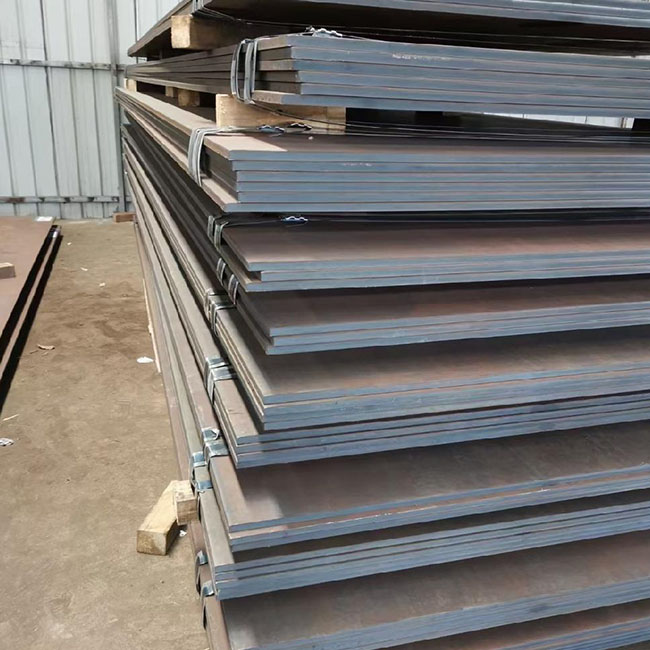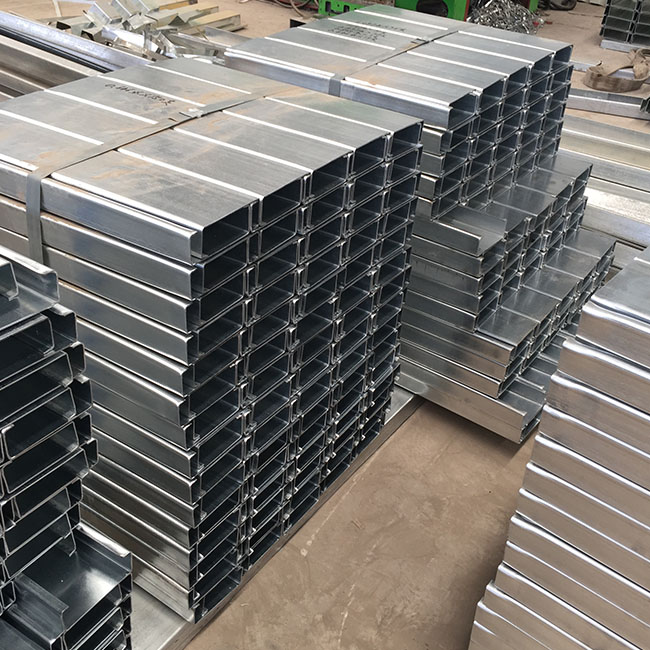Tel
+86-18837209569
- All
- Product Name
- Product Keyword
- Product Model
- Product Summary
- Product Description
- Multi Field Search
Views: 0 Author: Site Editor Publish Time: 2025-07-11 Origin: Site








Are you confused about choosing between galvanized and stainless steel? Both offer unique benefits, but which one is best for your project? In this article, we'll explore the key differences between galvanized steel and stainless steel. From their corrosion resistance to their strength and cost, we'll help you make the right choice for your needs.
Galvanized steel is coated with a layer of zinc to protect it from rust and corrosion. This zinc coating serves as a barrier, keeping oxygen and moisture away from the steel. However, over time, the zinc layer can wear off, especially if exposed to physical damage or harsh conditions. Once this layer is compromised, the steel underneath is susceptible to rust. Galvanized steel is great for short-term projects or mild environments but doesn't have the same long-lasting protection as stainless steel.
Stainless steel stands out because of its natural corrosion resistance. It contains a significant amount of chromium, which reacts with oxygen in the air to form a protective chromium oxide layer. This layer is self-healing, meaning if the surface gets scratched, the layer quickly reforms and continues to protect the steel. As a result, stainless steel remains rust-free and durable for much longer, even when exposed to harsh environments.
Galvanized steel is suitable for mild conditions, such as indoor use or outdoor structures that are not exposed to excessive moisture or chemicals. However, it's not the best choice for extreme conditions. Stainless steel, on the other hand, is built to handle much more challenging environments. Its resistance to rust, even in saltwater or extreme heat, makes it the preferred option for tough applications, including marine environments, chemical plants, and more.
● Marine Environments: Saltwater and high humidity can quickly deteriorate metals. Stainless steel excels in saltwater conditions, remaining resistant to corrosion for many years. Galvanized steel, while initially protective, can begin to rust and break down much sooner in these harsh conditions.
● Chlorinated Water: Pools and water treatment systems often expose materials to chlorinated water. Stainless steel performs exceptionally well in these environments, maintaining its strength and corrosion resistance. Galvanized steel, however, tends to corrode quickly when exposed to chlorine, especially when the zinc layer starts to degrade.
● Galvanized Steel: The zinc coating provides a decent level of protection but eventually wears away. Once it's gone, the steel is left exposed to the elements and prone to rust, which limits its durability. In high-moisture or high-chemical environments, this process is accelerated.
● Stainless Steel: Stainless steel's self-healing chromium oxide layer ensures that it remains rust-free for a long time, even in harsh conditions. It's highly durable and can last for decades without the need for significant maintenance. This makes stainless steel an excellent choice for projects where longevity is a key consideration.

Galvanized steel is strong for many everyday uses, but its strength can be compromised when the zinc coating is damaged. This protective layer helps prevent corrosion, but once it's worn down or scratched, the steel beneath can rust, reducing its overall durability and strength.
Stainless steel, on the other hand, boasts significantly higher tensile strength. This makes it ideal for applications where strength is crucial, such as in high-stress or heavy-duty environments. Unlike galvanized steel, stainless steel doesn't rely on an outer coating for protection, which means it maintains its strength over time.
When choosing between galvanized and stainless steel, the intended use and project requirements should guide the decision. For projects requiring high strength and durability, stainless steel is often the better choice. However, for more affordable options where strength is not as critical, galvanized steel may be sufficient.
● Construction: Galvanized steel is frequently used for structural supports, frames, and roofing in buildings. It's strong enough for these tasks but less ideal for heavy-duty applications. Stainless steel, on the other hand, is preferred when the strength requirements are higher, such as for load-bearing structures and reinforcement.
● Automotive and Aerospace: Stainless steel's superior tensile strength makes it the material of choice for high-stress components like car exhaust systems, engine parts, and aerospace structures. Its ability to withstand extreme conditions ensures durability and safety in these demanding environments.

Galvanized steel has a grey, matte finish that works well for practical uses but lacks the polished look of other materials. Over time, the zinc coating can fade or become damaged, which affects its appearance. Though functional and cost-effective, galvanized steel isn't typically chosen for projects where aesthetics are a priority.
Stainless steel, on the other hand, is known for its sleek, shiny, and modern look. Its smooth surface remains reflective and attractive, which makes it a popular choice for visible areas. Even in harsh conditions, stainless steel maintains its polished finish without degrading or tarnishing, making it a more visually appealing option.
When aesthetics are crucial, stainless steel is often the preferred material. It is widely used in kitchen appliances, where the shiny finish enhances the look of countertops, sinks, and stoves. Similarly, in decorative architecture and medical equipment, the clean and modern appearance of stainless steel is a key factor. Its ability to maintain its look over time makes it ideal for any project where visual appeal is important.
Galvanized steel is usually more affordable upfront. The process of galvanizing steel is simpler and less expensive compared to manufacturing stainless steel, which involves alloying and more complex procedures. This makes galvanized steel a great choice for budget-conscious projects, especially when corrosion resistance isn't a major concern.
While stainless steel costs more initially, its durability and minimal maintenance needs make it a better long-term investment. Stainless steel's resistance to corrosion and wear means it will last longer, reducing the need for replacements or repairs. Over time, its longevity can make up for the higher initial cost, especially for projects requiring a long lifespan.
Galvanized steel, while low-cost initially, needs ongoing maintenance. The zinc coating can wear off, especially when exposed to physical damage or harsh environments. This means you'll need to re-coat the steel to prevent corrosion, adding to the long-term costs.
Stainless steel, however, requires minimal maintenance. It doesn't need re-coating, and occasional cleaning is typically enough to keep it in good condition, saving on upkeep costs over time.
● Galvanized Steel: The lower initial cost can be appealing, but frequent re-coating or even replacement may be necessary as the zinc layer deteriorates. This could add up over time, especially in harsh environments.
● Stainless Steel: Despite the higher upfront cost, stainless steel's long lifespan, durability, and low maintenance can justify the investment. Its minimal upkeep requirements ensure that it remains cost-effective in the long run.
Galvanized steel needs more maintenance over time. The zinc coating that protects it from corrosion can get damaged, especially in harsh conditions. Regular inspections are necessary to check for any wear or scratches in the coating. If any damage is found, re-coating the steel is required to restore its protection, which can add to the maintenance costs.
Stainless steel is much easier to maintain. It doesn't need re-coating since it forms a natural corrosion-resistant layer. While it still requires occasional cleaning to keep its appearance and prevent buildup, it requires far less upkeep than galvanized steel. This makes stainless steel a more convenient choice for low-maintenance needs.
If repairs are needed, stainless steel is generally easier to handle. Scratches or minor surface damage can usually be polished or buffed out to restore its appearance. On the other hand, galvanized steel may require additional re-coating if the zinc layer is damaged, which can be more costly and time-consuming.
Both galvanized steel and stainless steel are recyclable. However, stainless steel is generally easier to recycle because it doesn't require the removal of coatings like galvanized steel does. The zinc coating on galvanized steel must be stripped off before it can be recycled, adding complexity to the process. In contrast, stainless steel can be melted down and reused without significant loss in quality. This makes stainless steel a more efficient material when considering its recyclability and environmental impact.
Stainless steel stands out for its long life and minimal need for maintenance. It can last for decades without showing signs of wear or corrosion, making it a more sustainable material in the long run. While galvanized steel may need frequent re-coating and eventual replacement, stainless steel remains durable and requires less frequent attention. This longevity reduces the need for new materials, making stainless steel a more sustainable option over time.
Both galvanized and stainless steel come with environmental costs in their production. Galvanizing steel is less energy-intensive than manufacturing stainless steel, which involves more complex processes, including alloying with elements like chromium and nickel. However, stainless steel's higher energy consumption is balanced by its longer lifespan and lower maintenance needs. This makes it a more eco-friendly choice in the long run, despite the higher initial energy requirements.
When deciding between galvanized and stainless steel, several factors should guide your decision. First, consider corrosion resistance. If your project is exposed to harsh weather, moisture, or chemicals, stainless steel offers superior protection. Strength is another important consideration. Stainless steel is stronger and more durable, making it ideal for heavy-duty applications. Cost plays a key role, too. Galvanized steel is more affordable, making it a great choice for budget-conscious projects. Finally, aesthetics should be considered. Stainless steel's sleek, shiny finish is perfect for projects where appearance matters, while galvanized steel is better suited for less visible, functional applications.
Galvanized steel is perfect for outdoor and industrial applications where corrosion resistance is important, but the exposure to harsh conditions is limited. It's often used for fences, railing, piping, and roofs. It's also a good choice when cost is a significant factor. For example, in large-scale construction projects where longevity isn't as critical, galvanized steel offers a solid, budget-friendly option.
Stainless steel shines in high-end applications where superior strength, corrosion resistance, and aesthetic appeal are required. It's commonly used in the medical field, kitchen appliances, architecture, and aerospace. If your project demands materials that can withstand extreme conditions or need to maintain a sleek look, stainless steel is the ideal choice.
Choosing the appropriate steel depends on industry-specific needs. For outdoor construction or agriculture, galvanized steel is a great, affordable option. In industries like medical or food processing, where hygiene and strength are paramount, stainless steel is the clear winner.
Both galvanized steel and stainless steel have their strengths and weaknesses. Galvanized steel is more affordable and great for many industrial and outdoor applications. However, stainless steel excels in durability, corrosion resistance, and aesthetic appeal.
For budget-conscious projects, galvanized steel is ideal. For high-end, long-lasting solutions, especially in demanding environments, stainless steel is the better choice. Choose based on your project's needs for cost, strength, and appearance. Welcome to Anyang Feiyue Consulting Products!
A: Yes, galvanized steel can be welded. However, the zinc coating can create harmful fumes during welding, so proper ventilation is necessary.
A: Stainless steel is better for marine environments due to its superior corrosion resistance in saltwater compared to galvanized steel.
A: Yes, stainless steel has higher tensile strength, making it stronger and more durable than galvanized steel.
A: Stainless steel is more expensive due to the complex alloying process, including the use of materials like chromium and nickel, which are costly.
Home | Products | Advantages | Application | Case | Company | Blog | Contact Us | Ferro Alloy | Steel | Refractory Material | Knowledge